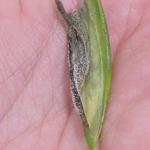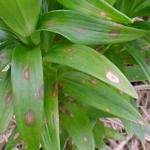Botrytis is one of those problems that can occur at any time conditions are right. There are several species of the fungus Botrytis, but Botrytis cinerea has the largest host range. Botrytis is often referred to as gray mold because it produces abundant fuzzy gray spores on the surfaces of infected tissues.
Signs and Symptoms
Although Botrytis attacks plants and flowers at any stage, tender new growth and aging or senescent tissues are preferred. Flowers petals provide an excellent food source for the production of spores. The fungus becomes established in flower petals and appears as irregular, enlarged, water-soaked or tan spots that eventually produce fuzzy gray fungal growth. Aging flowers are particularly susceptible. Petals of badly infected flowers stick together and become matted. During production, blossom and bud blight often precede and lead to infections on leaves and stems. These less obvious symptoms show as tan colored spots on leaves or cankers on stems that can eventually cause entire branches of plants to wilt, while the rest of the plant appears healthy. During storage and shipping, Botrytis causes blight or blast on leaf and flower buds. The fungus will also colonize dead or dying tissues anywhere conditions are right- in greenhouses, the field, packing sheds, coolers or during shipping.
Disease Cycle
Prolonged periods of cool, cloudy weather create an ideal environment for Botryis infections during production in a full greenhouse or out in the field. Like other fungi, Botrytis has a range of temperature and relative humidity that is necessary for spore germination, infection, and disease development. Spore germination and infection depends on a film of moisture for 8 to 12 hours, relative humidity of 85% or greater, and temperatures 55-65°F. Colonization of plant tissues takes place at a wide range of temperatures, but 60-75°F is optimum. Botrytis appears most often in spring and fall, because warm days followed by cool evenings result in condensation on plant surfaces.
Cultural Management
Once Botrytis develops, it cannot be effectively controlled with fungicides alone. The key to suppressing Botrytis is to keep the plant canopy dry, especially from dusk until dawn. Using drip irrigation or watering plants at the base instead of sprinkling or watering overhead will help to prevent Botrytis and many other leaf spot diseases. Increasing plant spacing to provide a less dense canopy will also help by allowing more air circulation and better fungicide coverage. Water just enough to prevent excess water on the floor, and water early enough in the day to allow plant surfaces to dry before evening reduces humidity and will help manage Botrytis.
- Heating and Venting Greenhouses to Lower Humidity
During cool times of the year, when a greenhouse is being heated, another practice to reduce humidity is to use a combination of ventilation and heating. Ventilation allows the exchange of moist greenhouse air with drier air from outdoors. Heating is necessary to bring outdoor air up to optimum growing temperature, and increases the capacity of the air to carry moisture, thus avoiding condensation. Neither practice alone is as efficient as both combined.
According to John Bartok, University of Connecticut Extension Professor-Emeritus, the method and time it takes for heating and venting will vary according to the heating and ventilation system in the greenhouse. John advises, in greenhouses with vents, the heat should be turned on and the vents opened an inch or so. Warm air will hold more moisture than cool air. The warm air will rise and escape from the greenhouse through the vents. Cooler air coming in from the outside will have lower relative humidity.
In greenhouses with fans, the fans should be activated and operated for a few minutes and then the heater turned on to bring the air temperature up. The fans should then be shut off. A timer could be set to activate the fans. A relay may be needed to lock out the furnace or boiler until the fans shut off so that both the fans and heating system do not operate at the same time and result in flue gases being drawn into the greenhouse.
The venting and heating cycle should be done two or three times per hour during the evening after the sun goes down and early in the morning at sunrise. The time it takes to exchange one volume of air depends on several factors including whether or not fans are used and, the size of the fans and vents. For some greenhouses it may take as little as 2-3 minutes air exchange. For greenhouses using natural ventilation, it may take 30 minutes or longer. Heating and venting can be effective even if it is cool and raining outside. Air at 50°F and 100% RH (raining) contains only half as much moisture as the greenhouse air at 70°F and 95% RH.
Even in a closed greenhouse, air movement helps reduce moisture on plant surfaces and in the crop canopy. A fan-jet or horizontal air flow system produces uniform temperatures and reduces the cool spots that can develop condensation problems. Air that is moving is continually mixed, resulting in very small temperature differences. The moisture does not get a chance to condense on the leaf surfaces because the mixing action caused by air movement prevents the air along the surface from cooling and causing condensation.
- Sanitation
In addition to reducing humidity and keeping foliage dry, sources of Botrytis infection need to be reduced. Botrytis spores are produced in abundance on senescing flowers and flower petals, lesions, and plant debris left behind during harvest, on the greenhouse floor, and in trash cans. Controlling weeds and removing plant debris during production and harvest helps to eliminate Botrytis. Regularly remove spent flowers and dying or dead leaves from plants and the soil surface and eliminate them from the greenhouse and field. Dispose of debris in plastic trash bags and avoid spreading spores by keeping the bag closed while moving it through the greenhouse or field. Be sure cull piles are not located near greenhouses or cut flower fields where spores can re-infect plants. Although this is labor intensive, it will help reduce spreading spores. Do not put plant debris in greenhouse trash cans as spores can escape when cans are opened.
Carry your sanitation program into post-harvest handling. Clean and sanitize coolers and cool rooms. To prevent Botrytis infections on flowers, foliage, and buds during shipping, avoid packing moist flowers and foliage after harvest. To prevent condensation of water droplets on flowers or foliage, avoid moving flowers directly from cool to warm rooms.
Chemical Management
A number of fungicides are labeled for use against Botrytis on ornamental crops: see the New England Greenhouse Floriculture Guide for a complete list of products. Products may be labeled for post-harvest use as well as during production: see individual product labels.
When making a fungicide treatment, treat thoroughly, reaching into the canopy area. Greenhouse populations of Botrytis rapidly develop resistance when exposed to repeated applications of fungicides with the same mode of action (FRAC Group). Resistance to thiophanate-methyl (Cleary's 3336) and iprodione (26 GT) has become common in Botrytis populations; therefore, these fungicides are no longer recommended. Group 11 fungicides (strobilurins) are very susceptible to fungicide resistance development and should not be applied consecutively or alternated with each other. Always alternate fungicide applications among materials with different modes of action to prevent resistance development. Another strategy is to use combination products or tank mix protectant fungicides like mancozeb, copper, or chlorothalonil with systemic fungicides.
References:
- Bartok J.W. and T. Smith. 2003. Reducing Humidity in the Greenhouse. (from this list of fact sheets on Greenhouse Management)
- Dole J.M. and M.A. Schnelle. The Care and Handling of Cut Flowers, Oklahoma Cooperative Extension Service, Fact Sheet F-6426.







0 comments
إرسال تعليق